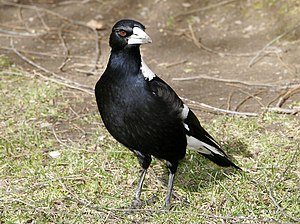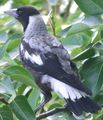Flute bird
| Flute bird | ||||||||||||
|---|---|---|---|---|---|---|---|---|---|---|---|---|

Flute bird ( Gymnorhina tibicen ) |
||||||||||||
| Systematics | ||||||||||||
|
||||||||||||
| Scientific name of the genus | ||||||||||||
| Gymnorhina | ||||||||||||
| GR Gray , 1840 | ||||||||||||
| Scientific name of the species | ||||||||||||
| Gymnorhina tibicen | ||||||||||||
| ( Latham , 1802) |
The flute bird ( Gymnorhina tibicen ) is a common songbird in Australia from the crows family (Cracticidae). The species is the only one of the genus Gymnorhina . Because of its black and white plumage it is in line with the magpie ( Pica pica ) in english called Australian Magpie. The bird became known worldwide through media reports about its attacks on humans. Its call is reminiscent of a flute melody, hence the German name.
The flute bird reaches a body length of around 40 cm and has a gray-black plumage that can vary regionally (four subspecies). The feet are black, the eyes reddish brown.
Distribution area
The flute bird is common throughout Australia and Tasmania . It is also found in New Zealand , where it was introduced by humans around 1860 and has created significant problems for the native bird world.
Way of life
The flute bird needs tall trees (e.g. eucalyptus forests) as a nesting and resting place as well as open spaces for foraging. It has an extremely versatile diet, both from vegetable and animal sources, mainly from insects and small animals, including carrion .
Flute birds live gregariously, also in the vicinity of human settlements. In addition to territorial-owning groups, there are vagabond groups without territory. When groups meet, fierce fighting can ensue. The flute bird breeds on tall, free-standing trees and usually only raises one young. In addition to twigs, he also uses household materials to build nests (just like the proverbial “thieving” magpie).
particularities
Flute birds can become very tame. They have the ability to imitate voices. The flute bird gained international fame through media reports about its attacks on people. During the breeding season from August to October, it ruthlessly attacks suspected intruders (swooping) near its nest . This can lead to minor injuries, but the inattentiveness can also lead to serious accidents or even death. In certain areas, children and cyclists have to wear protective helmets during this time, as the flute bird prefers to attack the head region from behind and without warning. Only constant eye contact with the bird prevents an attack. Resourceful people therefore paint eyes on the back of their helmets or wear sunglasses on the back of their heads.
Heraldic animal
The flute bird is found on the flag and coat of arms of the Australian state of South Australia .
Trivia
Internationally known from 2015 was a young flute bird who was accepted as a sick bird chick into the Australian family Bloom in Newport Beach (north of Sydney) and who gave the nurse Sam Bloom , who is paraplegic after an accident, new courage to face life. The photos and reports about the “penguin” christened bird, which participated intensively in family life, quickly spread via social media far beyond Australia. The book entitled Penguin Bloom , which was published in English in 2016 , was also published in German in February 2017.
The German composer Gerhard von Keußler , who lived in Australia from 1932 to 1935, based his Symphonic Fantasy Australia, which he completed in 1935 (premiered in Berlin 1939), on the call of the flute bird as a leitmotif.
A selection of images
Individual evidence
- ↑ The information in this article comes from the associated Wikipedia article in English and the web links listed below
- ↑ Boy killed trying to avoid magpie on brisbanetimes.com.au , accessed September 17, 2019
- ↑ Cyclist dies while fleeing swooping magpie in Woonona on abc.net.au , accessed on September 17, 2019
- ^ Penguin Bloom on worldcat.org , accessed March 3, 2017.
- ↑ Cameron Bloom, Bradley Trevor Greive: Penguin Bloom. The little bird that saved our family. Knaus, Munich 2017, ISBN 978-3-8135-0761-4 .
- ↑ Manuel Krönung: The oratorios of Gerhard von Keußler (1874-1949). Music with "Ethos" , Mainz 2010, p. 158.
Web links
- Australian Magpie. Department of Conservation and Land Management, Government of Western Australia, archived from the original on August 27, 2006 ; Retrieved September 9, 2012 .
- Side to flute birds in New Zealand (English)
- Audio file of the call
- Gymnorhina tibicen in the Red List of Threatened Species of the IUCN 2008. Posted by: BirdLife International, 2008. Accessed on December 23 of 2008.
- Videos, photos and sound recordings of Gymnorhina tibicen in the Internet Bird Collection



